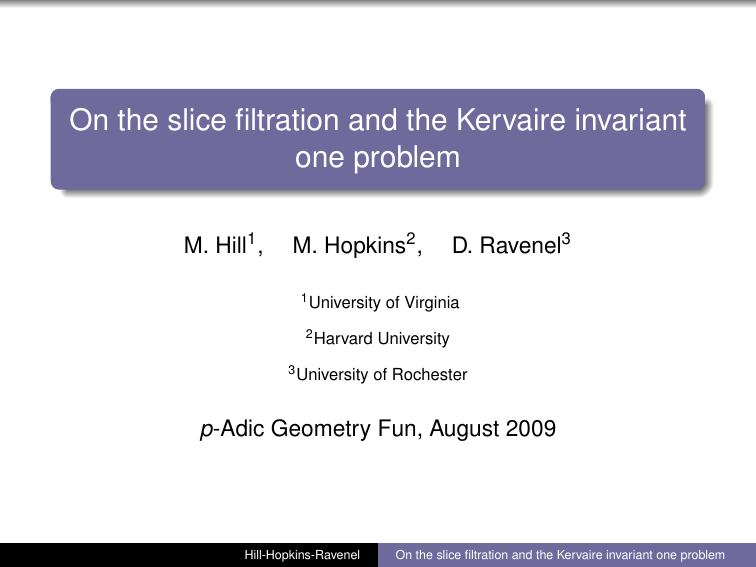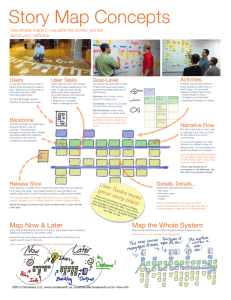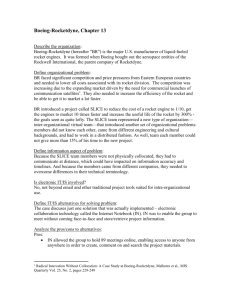On the slice filtration and the Kervaire invariant one problem M. Hill ,
advertisement

On the slice filtration and the Kervaire invariant
one problem
M. Hill1 ,
M. Hopkins2 ,
1 University
2 Harvard
3 University
D. Ravenel3
of Virginia
University
of Rochester
p-Adic Geometry Fun, August 2009
Hill-Hopkins-Ravenel
On the slice filtration and the Kervaire invariant one problem
Main Result
Theorem (H.-Hopkins-Ravenel)
There are smooth Kervaire invariant one manifolds only in
dimensions 2, 6, 14, 30, 62, and maybe 126.
Exemplars:
2
6
14
30
S1 × S1
SU(2) × SU(2)
62
S(O) × S(O)
Hill-Hopkins-Ravenel
(Bökstedt) Related to
E6 / U(1) × Spin(10)
Possibly a similar
construction.
On the slice filtration and the Kervaire invariant one problem
Geometry and History
1930s Pontryagin proves
{framed n − manifolds}/cobordism ∼
= πnS .
Tries to use surgery to reduce to spheres & misses an
obstruction.
1950s Kervaire-Milnor show can always reduce to case of
spheres...
Except possibly in dimension 4k + 2, where there is an
obstruction: Kervaire Invariant.
Hill-Hopkins-Ravenel
On the slice filtration and the Kervaire invariant one problem
Adams Spectral Sequence
HomA H ∗ (Y ), H ∗ (X )
[X , Y ]
Have a SS with
E2 = ExtA H ∗ (Y ), H ∗ (X )
and converging to [X , Y ].
(Adem) Ext1 (F2 , F2 ) is generated by classes hi , i ≥ 0.
j
hj survives the Adams SS if R2 admits a division algebra
structure.
Hill-Hopkins-Ravenel
On the slice filtration and the Kervaire invariant one problem
Browder’s Reformulation
Theorem (Browder 1969)
1
2
There are no smooth Kervaire invariant one manifolds in
dimensions not of the form 2j+1 − 2.
There is such a manifold in dimension 2j+1 − 2 iff hj2
survives the Adams spectral sequence.
Adams showed that hj itself survives only if j < 4
d2 (hj+1 ) = h0 hj2 .
Hill-Hopkins-Ravenel
On the slice filtration and the Kervaire invariant one problem
Previous Progress
h12 , h22 , and h32 classically exist.
Theorem (Mahowald-Tangora)
The class h42 survives the Adams SS.
Theorem (Barratt-Jones-Mahowald)
The class h52 survives the Adams SS.
Theorem (H.-Hopkins-Ravenel)
For j ≥ 7, hj2 does not survive the Adams SS.
Hill-Hopkins-Ravenel
On the slice filtration and the Kervaire invariant one problem
General Outline
There are four main steps
1
Reduce to a simpler homotopy computation which faithfully
sees the Kervaire classes
2
Rigidify the problem to get more structure and less
wiggle-room
3
Show homotopy is automatically zero in dimension −2
4
Show homotopy is periodic with period 28
Hill-Hopkins-Ravenel
On the slice filtration and the Kervaire invariant one problem
Reduction to Simpler Cases
Adams-Novikov SS
“More initial”
More complicated Ext
Adams SS
Contains our classes
ExtA (F2 , F2 )
Hill-Hopkins-Ravenel
HFP SS
Algebraically simple
H ∗ (Z/8; R)
Slice SS
Honest equivariant
π∗ (R Z/8 )
On the slice filtration and the Kervaire invariant one problem
Benefits of Reduction
Reduction is purely algebraic!
1
Lifting from Adams to Adams-Novikov is well understood.
2
Reduction from Adams-Novikov to homotopy fixed points is
formal deformation theory.
So good choice of R gives us something that is
easily computable
strong enough to detect the classes.
Hill-Hopkins-Ravenel
On the slice filtration and the Kervaire invariant one problem
Why Go Equivariant?
Simplify computation by adding extra structure:
equivariance.
Here have fixed points, rather than homotopy fixed points.
And there are spheres for every real representation.
Example
If G = Z/2, then have S ρ2 = C+ and S 2 .
Hill-Hopkins-Ravenel
On the slice filtration and the Kervaire invariant one problem
What is R?
1
Begin with MU with Z/2 given by complex conjugation.
2
“induce” up to a Z/8 spectrum:
MU
N
MU
(−)
N
MU
N
MU
3
The geometric fixed points spectrum for the Z/8-action is
geometric.
4
This is a piece of the simplicial THH construction Teena
gave for MU.
Hill-Hopkins-Ravenel
On the slice filtration and the Kervaire invariant one problem
Advantages of the Slice SS
24 ◦
◦
◦
20
◦
◦
◦
22
◦
◦
◦
◦
◦
◦
◦
18
16 ◦
◦
◦
12
◦
◦
◦
14
◦
◦
◦
◦
◦
◦
◦
10
8 ◦
◦
◦
4
◦
◦
◦
◦
◦
◦
◦
◦
F
2
0
◦
◦
6
−2
−4
−6
−8
−10
−12
−24 −22 −20 −18 −16 −14 −12 −10 −8 −6 −4 −2
Hill-Hopkins-Ravenel
0
2
4
6
8
10
12
14
16
18
20
22
24
On the slice filtration and the Kervaire invariant one problem
Advantages of the Slice SS
24
◦
22
20
◦
18
16
◦
◦
14
12
◦
◦
10
8
◦
◦
◦
6
4
◦
◦
◦
2
0
−2
−4
−6
−8
◦
◦
◦
◦
◦
◦
−10
◦
−12
−24 −22 −20 −18 −16 −14 −12 −10 −8 −6 −4 −2
Hill-Hopkins-Ravenel
0
2
4
6
8
10
12
14
16
18
20
22
24
On the slice filtration and the Kervaire invariant one problem
Basic Idea of Slices
Want to decompose an equivariant X into computable pieces.
Similar to Postnikov tower.
Key difference: don’t use all spheres!
Acceptable Ones
1
2
3
4
S k ρ8 ,
Unacceptable Ones
S k ρ8 −1
1
Z/8 ⊗Z/4 S k ρ4
2
Z/8 ⊗Z/2 S k ρ2
3
Z/8 ⊗ S k
4
Hill-Hopkins-Ravenel
S k ρ8 −2
Z/8 ⊗Z/4 S σ
Z/8 ⊗Z/2 S σ−1
Sk
On the slice filtration and the Kervaire invariant one problem
Computing with Slices
Key Fact
For spectra like MU, slices can be computed from equivariant
simple chain complexes.
These algebraically describe the fixed points of the acceptable
spheres.
Cellular Chains for S ρ4 −1
Gives the chain complex
Z4 → Z4 → Z2 → Z = C• .
Maps determined by
H∗ (C• ) = H̃∗ (S 3 ).
Hill-Hopkins-Ravenel
On the slice filtration and the Kervaire invariant one problem
Gaps
Theorem
For any non-trivial subgroup H of Z/8 and for any slice sphere
Z/8 ⊗H S ρH ,
Z/8
H−2 (C∗ ) = 0
The proof is an easy direct computation:
1
2
3
If k ≥ 0, then we are looking at something connected.
If k ≤ 0, then we look at the associated cochain algebra.
In the relevant degrees, the complex is Z → Z2 by
1 7→ (1, 1).
Hill-Hopkins-Ravenel
On the slice filtration and the Kervaire invariant one problem
Gap Theorem
Theorem
π−2 (R) = 0.
Proof.
Slices of MU ⊗ MU ⊗ MU ⊗ MU are all of the form
HZ ⊗ (Z/8 ⊗H S k ρH ).
Class we are inverting is carried by an S k ρ8 .
Inversion is a colimit and first steps show π−2 = 0.
Hill-Hopkins-Ravenel
On the slice filtration and the Kervaire invariant one problem
Connections to K -Theory
Recall from Teena’s Talk:
TC(A) can be computed from TR∗· (A)
C
TRqn (A, p) = πq THH(A) pn−1 .
These are homotopy groups of honest fixed points and the
maps essentially come from equivariant structure
All of this is computable with slice machinery
Hill-Hopkins-Ravenel
On the slice filtration and the Kervaire invariant one problem
General Benefits of Slices
Hill-Hopkins-Ravenel
On the slice filtration and the Kervaire invariant one problem
Computing TR
Slice machine can much more general. Can build slice spectral
sequences for other collections of cells
1
Should have nice connectivity properties
2
Should be “closed under restriction” = a Mackey functor in
sets or subcategories
3
Should make cellular objects being considered simpler.
Possible Collection: L = C, k · L, L ⊕ L2 ⊕ · · · ⊕ Ld .
Hill-Hopkins-Ravenel
On the slice filtration and the Kervaire invariant one problem






